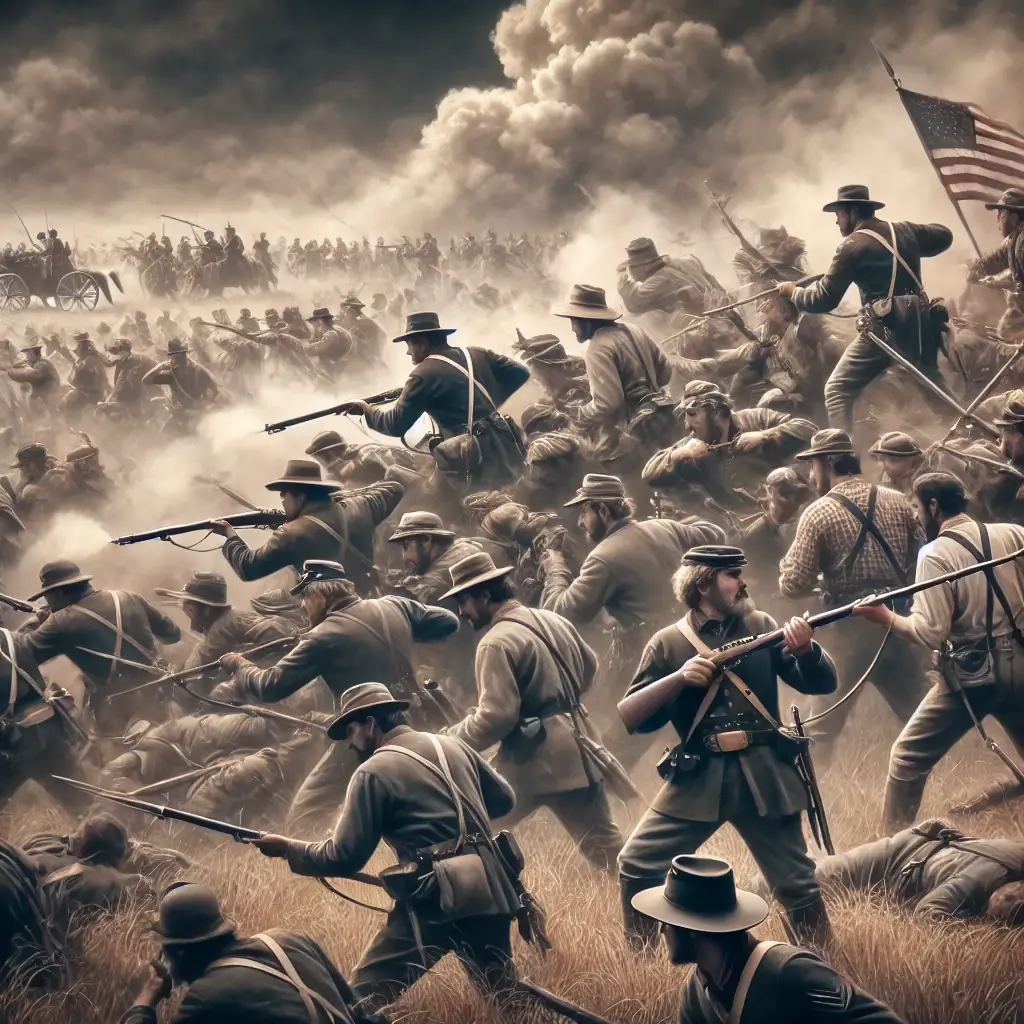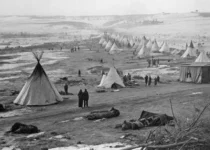Battle of Gettysburg
The Battle of Gettysburg: A Turning Point in American History
The Battle of Gettysburg, fought from July 1 to July 3, 1863, was one of the most significant and bloodiest battles in the American Civil War. It marked a turning point in the conflict and ultimately led to the defeat of the Confederate forces. With over 50,000 casualties, this battle remains a critical chapter in American history, symbolizing both sacrifice and a shift toward the preservation of the Union.

In this article, we will explore the causes, key events, and impact of the Battle of Gettysburg. Through a detailed examination, we aim to provide insight into why this battle is remembered as a pivotal moment in American history.
[su_box title=”Battle of Gettysburg – Next years” box_color=”#fb0400″]
- Tuesday, 1 July 2025
- Wednesday, 01 July 2026
- Thursday, 01 July 2027
- Saturday, 01 July 2028
[/su_box]
What Led to the Battle of Gettysburg?
The events leading up to the Battle of Gettysburg were fueled by the ongoing conflict between the Union and Confederate forces. The Confederate Army, led by General Robert E. Lee, sought to invade the North in hopes of forcing the Union to negotiate peace. By advancing into Pennsylvania, Lee aimed to disrupt the Union’s morale and potentially sway foreign powers to recognize the Confederacy.
The Confederate Strategy: Lee’s Northern Invasion
In June 1863, General Lee led his army into Northern territory, with the intention of striking a decisive blow. His strategy was clear: a victory on Northern soil would demoralize the Union and strengthen the Confederate cause. Lee’s forces moved into Pennsylvania, capturing supplies and creating a sense of urgency for Union forces.
Union Forces Respond
Meanwhile, Union General George G. Meade had just been appointed commander of the Army of the Potomac. His challenge was to track and confront Lee’s advancing army. The stage was set for an inevitable and monumental confrontation in the small town of Gettysburg, Pennsylvania.
The Battle Unfolds: Three Days of Combat
The Battle of Gettysburg can be broken down into three intense days of combat, each with its own key moments and strategies.
Day 1: Initial Engagements
The first day of battle began on July 1, 1863, when Confederate forces clashed with Union troops just outside of Gettysburg. The Union army, initially outnumbered, was forced to retreat to higher ground on Cemetery Hill. This gave them a defensive advantage for the coming days.
- Confederate forces pushed Union troops back, but failed to capitalize on their early gains.
- The Union army quickly reinforced their position, preparing for what would become a critical stand.
Day 2: The Fight for High Ground
On July 2, the battle escalated as both sides sought control of key positions. The Union forces held strong defensive positions on Cemetery Ridge and Little Round Top.
- Confederate assaults were launched on the Union’s left flank, but fierce resistance held them back.
- The battle for Little Round Top became legendary, as Union forces, led by Colonel Joshua Chamberlain, successfully defended this strategic point.
Day 3: Pickett’s Charge
The final day of the battle, July 3, is best remembered for Pickett’s Charge, a bold but ultimately disastrous Confederate assault on the center of the Union lines.
- General George Pickett led approximately 12,500 Confederate soldiers in a direct attack on Union positions along Cemetery Ridge.
- The assault was met with overwhelming Union firepower, resulting in massive Confederate losses and a decisive defeat.
Pickett’s Charge marked the end of the Confederate offensive at Gettysburg. The Union had successfully repelled the invasion, and Lee’s army was forced to retreat back to Virginia.
Why the Battle of Gettysburg Was a Turning Point
The Battle of Gettysburg is often regarded as the turning point of the Civil War for several key reasons:
1. The End of Confederate Invasions into the North
Gettysburg was the last time General Lee’s army would invade Northern territory. The failure of this campaign shifted the momentum of the war in favor of the Union.
2. A Devastating Blow to Confederate Morale
With massive casualties and no decisive victory, the Confederate army’s morale was significantly weakened. The loss at Gettysburg, combined with the surrender of Vicksburg on July 4, 1863, dealt a critical blow to the Confederacy.
3. Strengthening of Union Resolve
For the Union, the victory at Gettysburg provided a much-needed boost to both military and civilian morale. It reinforced the belief that the war could be won and that the Union could be preserved.
4. A Prelude to Lincoln’s Gettysburg Address
In November 1863, President Abraham Lincoln delivered the Gettysburg Address, one of the most famous speeches in American history. His brief but powerful words redefined the purpose of the war, emphasizing the principles of equality and the importance of national unity.
The Aftermath of the Battle
The Union’s victory at Gettysburg came at a steep cost. More than 50,000 soldiers were killed, wounded, or missing over the course of three days. The battlefield itself became a symbol of sacrifice and the brutal realities of war.
Casualties and Losses
- Union Army: 23,000 casualties, including 3,155 killed.
- Confederate Army: 28,000 casualties, including 3,903 killed.
The staggering losses on both sides underscored the immense human cost of the conflict.
Lee’s Retreat and the Road to Appomattox
Following the defeat at Gettysburg, General Lee’s army retreated back to Virginia. Although the war would continue for nearly two more years, the defeat marked the beginning of the end for the Confederacy. Lee’s forces would never again mount a significant offensive campaign, and the Union continued to press its advantage.
The Significance of the Battle of Gettysburg Today
The Battle of Gettysburg is remembered not only for its military significance but also for its lasting impact on American identity and values.
Gettysburg National Military Park
Today, the battlefield is preserved as part of the Gettysburg National Military Park, a site visited by millions each year. It serves as a reminder of the sacrifices made during the Civil War and a place of reflection on the broader themes of freedom, equality, and national unity.
The Legacy of the Gettysburg Address
President Lincoln’s Gettysburg Address continues to resonate as a defining statement of American ideals. In just 272 words, Lincoln captured the essence of the nation’s struggle and its dedication to the principles of democracy and human rights.
Lessons Learned from the Battle of Gettysburg
The Battle of Gettysburg offers important lessons for both military strategy and leadership. General Meade’s ability to take the high ground and Lee’s overconfidence in Pickett’s Charge are often studied as examples of tactical decisions that can shape the outcome of battles.
1. The Importance of Terrain in Military Strategy
Holding the high ground gave Union forces a critical advantage, allowing them to repel Confederate attacks more effectively. This lesson continues to be relevant in modern military tactics.
2. The Impact of Leadership
Both General Meade and General Lee made key decisions during the battle that influenced its outcome. Meade’s defensive strategy and Lee’s aggressive tactics highlight the complexities of leadership in times of conflict.
The Battle of Gettysburg was a defining moment in the American Civil War. It marked a turning point in the conflict, halted Confederate advances, and paved the way for the eventual Union victory. The bravery and sacrifice of the soldiers who fought there continue to be remembered and honored today.
While the battle may be over, its legacy endures, reminding us of the high cost of war and the enduring struggle for freedom and unity.
FAQs
1. Why is the Battle of Gettysburg considered a turning point?
The Battle of Gettysburg is considered a turning point because it ended General Lee’s invasion of the North and marked the beginning of a shift in momentum in favor of the Union.
2. How many soldiers died at the Battle of Gettysburg?
There were over 50,000 casualties at the Battle of Gettysburg, with approximately 7,000 soldiers killed on both sides.
3. What was Pickett’s Charge?
Pickett’s Charge was a Confederate assault led by General George Pickett on the third day of the Battle of Gettysburg. It resulted in heavy losses for the Confederates and a decisive Union victory.
4. Where is the Gettysburg battlefield located?
The Gettysburg battlefield is located in Gettysburg, Pennsylvania, and is now part of the Gettysburg National Military Park.
5. How did the Battle of Gettysburg impact the Civil War?
The battle significantly weakened Confederate forces and morale, giving the Union a strategic advantage that would ultimately lead to their victory.


